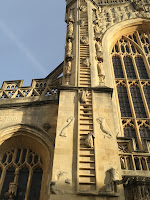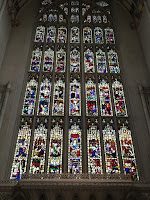Join me in welcoming Catherine Hokin to my blog today! I am happy to be a part of the blog tour to announce the release of Catherine's novel, Blood and Roses, in which she challenges some of the best known myths surrounding Margaret of Anjou. If the name alone conjures up images of a villain, read on. ~ Samantha
The Margaret Myths
“Foreigner, white devil, shrew, virago,
vengeful fury.”
I am indebted to Dorothea Kehler (Shakespeare’s Widows) for that brilliant
summation of the way Shakespeare portrays Margaret
of Anjou (1430-1482), the protagonist of my novel Blood and Roses. Our
beloved bard is rather obsessed with her – Margaret appears in all three parts
of Henry IV and, with a complete
disregard for historical fact, in Richard
III where Shakespeare pulls no punches, describing her as “a foul wrinkled witch’ and a ‘hateful with’red hag.”
Shakespeare’s
Margaret is evil and twisted almost to the point of parody: wandering round Court clutching the severed head of her supposed
lover the Duke of Suffolk; rubbing a cloth soaked in his son’s blood all over
the Duke of York’s face before placing a paper crown on his head and stabbing
him; prophesying evil falling on the House of York like a medieval Cassandra. As
a character portrayal it is over-wrought at best; as an historical source it is
deeply suspect, as we would expect given that the plays were written for
Elizabeth I as pieces of political propaganda. But the myths about the evil ‘she-wolf’ persist and Shakespeare’s
portrayal is the one many people recognise, which is where I came in…
The
challenge for a historical novelist is to get underneath the sources, separate
the fact from the fiction (often just as important) and find the stories hidden
in the gaps – imagine miners scrabbling in the dark for that nugget which turns
those never-ending ‘but why?’ moments into narrative gold.
I
like challenging women who won’t conform to the customs and pre-conceptions of
their time, Margaret always struck me as the epitome of this which is why I
chose her as the protagonist of my first novel.
There
is, of course, the real Margaret and my Margaret. The
real Margaret was described by a contemporary as a “great and strong-laboured
woman” – that fits the bill rather nicely. She was a Queen Consort – her role
was essentially to be an intercessor and a peacemaker which is all very well
except she was married to the weak, ill and ineffectual King Henry VI at a time
when the English Crown was very much the spoils of war. Margaret’s crime? She was politically
astute, well-educated (by very strong women role models) and perfectly able to
rule in an England that would not countenance her doing so. Her punishment? To be made the
scapegoat for her husband’s failings, a not uncommon process of female
vilification in the medieval period as Diana
E.S. Dunn discusses in War and Society in Medieval Britain.
So
who is my Margaret? I hope you will find everything
the real one was and more: a strong, deeply intelligent women driven by ambition
and perfectly capable of manipulating circumstances to her own advantage – believe me, Jacquetta Woodville in my novel
deeply regrets ever pretending to play at witchcraft.
What
is she not? A crone, a murderess or a woman so
foolish that she would take a cast of lovers including the Duke of Suffolk who
was 34 years older than her, only a man could have written that…
Blood
and Roses – it’s not a romance, there’s far too
much blood for that but I hope it is a portrayal of a woman you will be as
fascinated by as me. Perhaps I need to let you hear from the lady herself in a
short extract…
I am alone.
She sat in a Court
bustling with people and knew the truth of it.
I am alone.
If anyone of them knew what I plan to do, what I will make Jacquetta
and Rivers party to, they would drive me from this throne and there would be no
one to defend me.
I am alone but I am winning.
The thought
brought a smile to her lips and everyone watching her wondered what brought
such a sparkle to her eyes and a softening to her face the Court rarely saw
these days.
I am winning because they hate me less than they despise York for
his ambitions and pretensions.
Her smile deepened
as she remembered the reluctance with which York had been forced to swear his
allegiance to Henry just days before when the support he presumed would follow
his second attack on Somerset had simply melted away. It was a smile so full of
warmth, the courtiers began to look around them for the object of her
delight.
She was no fool;
she could sense the power in the country shifting. There were risings from
Derbyshire to Devon, local grievances in the main but with the potential to
become far more dangerous. It was already becoming treacherously unstable in
the North where the Nevilles and the Percies had rekindled past hatreds and
looked set to plunge the whole region into chaos. And she knew well enough how
close York was to his nephew Richard
Neville, Earl of Warwick, knew that he would watch the North like a hawk ready
to swoop and make any rebellion his.
But, for now, she
was winning and York was gone from Court and, if the real danger was not in the
plan but in the execution, she was ready to face that. So she smiled and her women whispered and she
hugged her secret close.
About Blood and Roses
Blood and Roses – a novel of Margaret of Anjou and her pivotal
role in the Wars of the Roses by Catherine Hokin.
1460
The English Crown – a bloodied, restless prize.
The one contender strong enough to hold it? A woman.
Margaret of Anjou: a French Queen in a hostile country, born to rule but
refused the right, shackled to a King lost in a shadow-land.
When a craving for power becomes a crusade, when two rival
dynasties rip the country apart in their desire to rule it and thrones are the
spoils of a battlefield, the stakes can only rise. And if the highest stake you
have is your son?
You play it.
Blood and Roses, a work of historical fiction, retells the story
of Margaret of Anjou (1430-82), wife of Henry VI and a key protagonist in the
Wars of the Roses. This is a feminist revision of a woman frequently
imagined only as the shadowy figure demonised by Shakespeare. Blood
and Roses examines Margaret as a Queen unable to wield the power and authority
she is capable of, as a wife trapped in marriage to a man born to be a saint
and as a mother whose son meets a terrible fate she has set in motion.
The story opens in 1480 with Margaret as an unwilling exile in France and is
structured as a reflection on the events of her life and the relationships that
shaped it, primarily her son Edward, her husband Henry IV, Anne Neville and the
Earl of Warwick.
The novel spans 1435 to 1480. The dynastic conflicts around the throne,
known to a modern audience as the Wars of the Roses, are the main backdrop to
the story including the battles which were some of the bloodiest ever
fought.
The main conflicts in the novel
reflect both the issues of the age – the challenge of holding onto a crown
in a kingdom riven by dynastic struggle in which loyalties shift like quicksand
– and the personal price to be paid by being a woman outside her
time. In trying to resolve her marriage and its desperate
need for an heir, shape her son for a dangerous future and reconcile her
ambition with her lack of power, does Margaret become the author of her own
fate?
A key issue for historians has been the relationship between Margaret of Anjou
and her husband Henry IV (who suffered from what has been described as
narcolepsy, resulting in long periods of what are best described as coma) and
the paternity of her son, born 8 years into what was a seemingly barren
marriage. Blood and Roses offers a solution to the paternity question
rooted in Margaret’s political acumen and her relationship with Jacquetta
Woodville – a friendship which ended in a betrayal that has never been fully
explored.
This is a novel about power: winning it, the sacrifices made for it and its
value. It is also a novel about a woman out of her time, playing a game ultimately
no one can control.
 Catherine is a Glasgow-based author with a degree in History from Manchester University. After years of talking about it, she finally started writing seriously about 3 years ago, researching and writing her debut novel, Blood and Roses, which will be published in January 2016 by Yolk Publishing. The novel tells the story of Margaret of Anjou and her pivotal role in the Wars of the Roses, exploring the relationship between Margaret and her son and her part in shaping the course of the bloody political rivalry of the fifteenth century. About a year ago, Catherine also started writing short stories - she was recently 3rd prize winner in the 2015 West Sussex Writers Short Story Competition and a finalist in the Scottish Arts Club 2015 Short Story Competition. She regularly blogs as Heroine Chic, casting a historical, and often hysterical, eye over women in history, popular culture and life in general.
Catherine is a Glasgow-based author with a degree in History from Manchester University. After years of talking about it, she finally started writing seriously about 3 years ago, researching and writing her debut novel, Blood and Roses, which will be published in January 2016 by Yolk Publishing. The novel tells the story of Margaret of Anjou and her pivotal role in the Wars of the Roses, exploring the relationship between Margaret and her son and her part in shaping the course of the bloody political rivalry of the fifteenth century. About a year ago, Catherine also started writing short stories - she was recently 3rd prize winner in the 2015 West Sussex Writers Short Story Competition and a finalist in the Scottish Arts Club 2015 Short Story Competition. She regularly blogs as Heroine Chic, casting a historical, and often hysterical, eye over women in history, popular culture and life in general.
Connect with Catherine Hokin
Connect with Catherine Hokin through her website, blog, Facebook, or Twitter.
Get Blood and Roses at Amazon.co.uk or Amazon US!




























